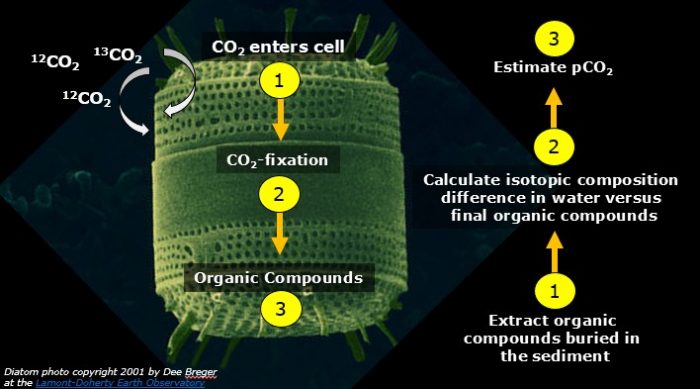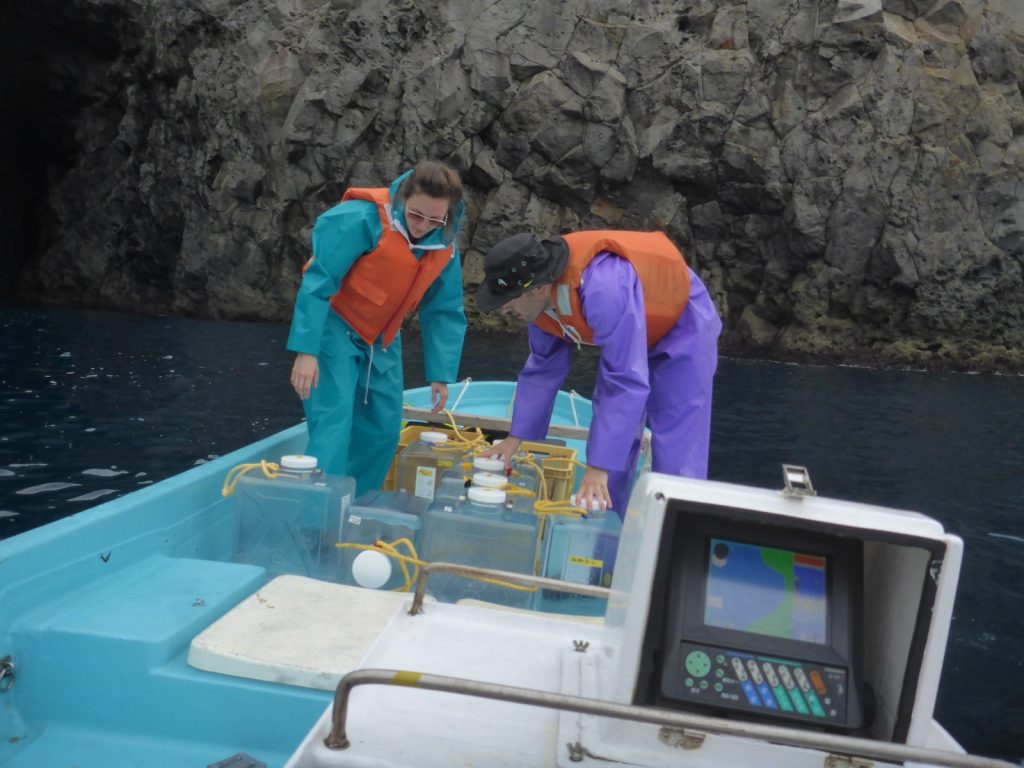
Name of proxy
Phytane, a compound resulting from the degradation of Chlorophyll-a (Chl a), a green pigment in plants and algae that is involved in photosynthesis
Type of record
Atmospheric carbon dioxide concentrations
Paleoenvironment
Marine sediments and oils
Period of time investigated
Phanerozoic (last 540 million years)
How it works
Before we can start predicting the potential impact of human activities on climate change, we first need to study the behavior of atmospheric CO2 concentration (pCO2) in the past. This represents a challenge given that continuous atmospheric measurements started only about 60 years ago.
To reconstruct past pCO2, a single well-constrained, ubiquitous proxy would be ideal. Unfortunately, it does not exist and we have to combine the estimates from many different types of proxies, each with their own advantages and weaknesses.
Different potential compounds that can give information on the pCO2 over the last hundreds of millions of years have been explored. The idea is based on the fact that algae consume CO2 and use that carbon to build organic compounds. But carbon atoms are not all the same. They can have different masses depending on the composition of their nucleus. We therefore differentiate between heavy carbon (13C) and light carbon (12C). Algae rather use the lighter, more common carbon (12C), but when less CO2 is available, they must use both 12C and 13C– or go hungry.
Therefore, it is considered that the more abundant is the CO2, the smaller is the 13C/12C ratio of the algae. Likewise, when CO2 is lower, the 13C/12C ratio in algae is higher. Long after an algae died, the 13C/12C ratio of its organic compounds will remain preserved in ancient sediments and oils and reflect the environment in which they were first produced.
Consequently, this ratio is compared to the ratio in CO2 consumed by the algae in order to calculate the fractionation factor (Ɛp) due to CO2-fixation. The fractionation factor is a measure of the discrimination occurring between heavy and light carbon. It can therefore be used to estimate the abundance of CO2 at the time the organic compounds were first produced.
Key Findings
This pCO2 estimation method via Ɛp is generally applied to organic compounds that come from specific species of algae. However, this has limitations – a single species is limited by its evolutionary history and its global abundance.
Here instead, we decided to explore the possibilities of using a general biomarker – an organic compound that all algae have and that contributes to the ocean record. We have explored naturally occurring CO2 vents, pockets of bubbling CO2 caused by volcanic activity, to test several different general biomarkers using this Ɛp method.
One of the biomarkers that seems to work well are phytol and phytane, which are byproducts of Chl a – a green pigment in plants and algae involved in photosynthesis. Phytane was used in specific case studies (e.g. Bice et al., 2006; Damste et al., 2008) but has not been tested extensively. We are now calibrating this potential proxy, by comparing it with other well-established pCO2 proxies over different timescales, and forming a compilation that extends the entire Phanerozoic (the past 540 million years!).
This proxy could significantly increase how far we can reconstruct pCO2 – Chl a and its products have been found in samples over 2 billion years old and is found everywhere (both spatially and temporally) throughout the geologic record.
Edited by Caroline Jacques and Célia Sapart
Further readings
Bice, K. L., Birgel, D., Meyers, P. A., Dahl, K. A., Hinrichs, K. U., & Norris, R. D. (2006). A multiple proxy and model study of Cretaceous upper ocean temperatures and atmospheric CO2 concentrations. Paleoceanography, 21(2).
Damsté, J. S. S., Kuypers, M. M., Pancost, R. D., & Schouten, S. (2008). The carbon isotopic response of algae,(cyano) bacteria, archaea and higher plants to the late Cenomanian perturbation of the global carbon cycle: Insights from biomarkers in black shales from the Cape Verde Basin (DSDP Site 367). Organic Geochemistry, 39(12), 1703-1718.

